Here, we will discuss Giant Gourami’s complete care guide. The Giant Gourami (Osphronemus goramy) is a freshwater fish from slow-moving waters in Southeast Asia. Giant Gouramis are large compared to other fish in the Osphronemidae family; therefore, these gouramis are called Giant Gouramis.
It is a member of the gourami family and can grow to be large, up to 20 inches in length! This fish is popular in the aquarium trade and is known for its beautiful colors and patterns.
They are full of personality, like other gourami fish, and are easy for beginners to care for. Finding tank mates for Giant Gouramis is easy. As long as Giant Gouramis live in a tank with other similar-sized fish, the gouramis will not cause any drama.
Aquarists who love keeping plants and algae in the aquarium should consider supporting Giant Gouramis. Aquascaping the aquarium aesthetically and practically is essential in a Giant Gourami tank.
Table of Contents
Species Summary
| Scientific name: | Osphronemus goramy |
| Care Level: | Easy |
| Temperament: | Peaceful |
| Color: | Soft golden yellow with pale blue stripes |
| pH Level | 6.5-8.0 |
| Temperature Range: | 68°-86°F |
| Lifespan: | 5-8 years |
| Size: | Up to 20 inches long |
| Diet: | Omnivore |
| Family: | Osphronemidae |
| Origin | Southeast Asia |
| Minimum Tank Size: | 200 gallons |
| Tank Set-Up: | Freshwater with live plants |
| Compatibility: | Any large peaceful fish |
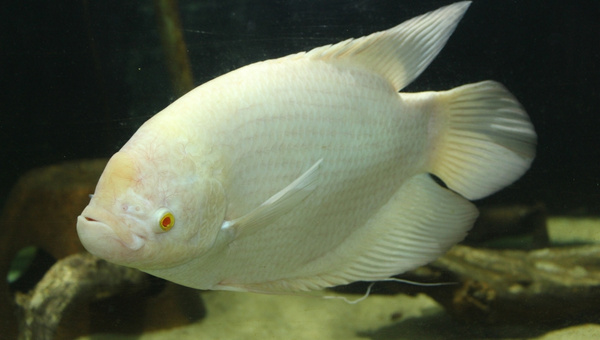
Giant Gouramis are widely available in the aquarium trade. Pet shops and aquariums sell Giant Gouramis as juveniles. Therefore, they are usually sold when they are about 4 inches (10 cm) long. The average cost of Giant Gourami is between $30 to $200. But Giant Gourami fish numbers are falling in the wild.
Also, check Dwarf Gourami Detailed Care Guide, Diseases, Cure & All.
Some online stores where they can be found are:
- LiveAquaria.com
- Petco.com
- ThatFishPlace.com
Giant Gourami Size and Growth Rate
Giant Gouramis can grow large, reaching lengths up to 3 feet (90 cm). However, they are typically much smaller in captivity, with an average size of around 2 feet (60 cm).
The growth rate of Giant Gouramis is relatively fast, with fish reaching their full size within a year or two if given good care.
You may also check Butterfly Betta Care Guide: Appearance, food & Diet, Breeding & All.
Giant Gourami Lifespan
Giant Gourami has an average lifespan of 5-8 years, though some individuals have been known to live up to 10 years with proper care.
Giant Gourami Appearance
Giant Gouramis are very large, slow-moving fish that can reach up to 3 feet in length. They have long, slender bodies with iridescent scales ranging from pale green to dark blue. Their fins are often brightly colored, and their mouths are giant and downturned, which is how they get their nickname of “kissing gourami.”
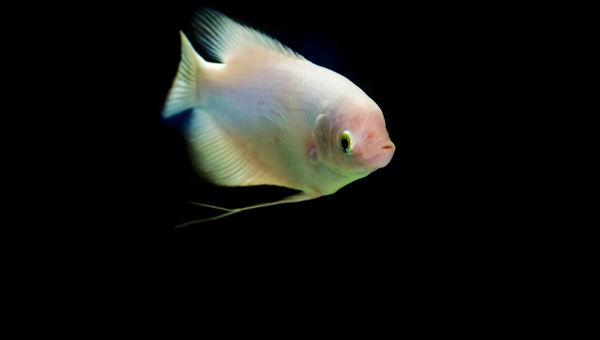
These fishes have pointed snouts and unique flat heads, which is unusual for gouramis and makes Giant Gouramis easy to identify.
Check: Ultimate Dragon Goby 101: Care, Appearance, Food, Habitat & All
Giant Gourami Behavior and Temperament
Giant Gouramis are relatively peaceful fish but can be aggressive towards smaller tank mates. They are also known to be nippy towards long-finned fish and slow-moving fish. It is best to keep them with other large, robust fish that can hold their own.
Also, check: Rummy Nose Tetra 101: All You Need To Know.
Like every other gourami species of fish, male Giant Gouramis are much smaller and more streamlined than female fish. Female Giant Gouramis have a rounded dorsal fin, whereas male fish have a more pointed dorsal fin. Male Giant Gouramis look streamlined compared to female Giant Gouramis, who have rounded bellies.
Here are some similarities throughout the species to look out for when identifying Giant Gouramis:
- Long, slender bodies
- Brightly colored fins
- Flat heads
- Largemouths
Check: Clown Loach Care: Appearance, Tank Mates, Lifespan, Breeding & All
Giant Gourami Breeding
Giant Gouramis are mouthbrooders, meaning that the female incubates the eggs in her mouth until they hatch. When ready to breed, the male will build a bubble nest at the water’s surface. Once the nest is complete, the female will be introduced, and spawning will begin.
The female can lay up to 2000 eggs, which the male will then fertilize. Once the eggs are fertilized, the female will pick them up in her mouth and incubate them for about two weeks. The fry will be released once they are free-swimming and can fend for themselves.
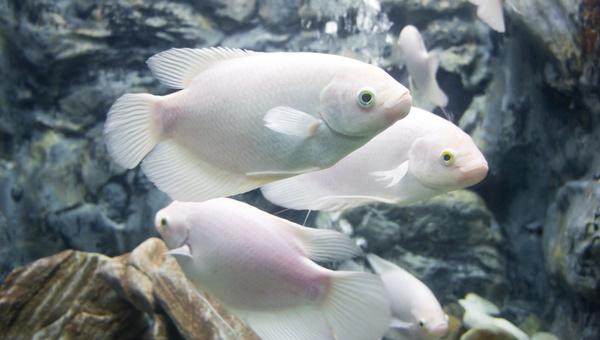
Giant Gouramis are not difficult to breed, but it is best to leave them in their natural environment. If you breed them in captivity, ensure the tank is at least 50 Gallons and has plenty of hiding places.
The water should be clean and well-filtered, with a pH between 6.5 and 8.0. It is also essential to provide plenty of live food for the fry once they are released.
Check: Cherry Shrimp Care Guide: Appearance, Food & Diet, Lifespan & All
Giant Gourami Complete Care Guide
Giant Gouramis are easy to fish to care for and make good community fish. They are best kept in an aquarium of at least 150 gallons with other peaceful fish. The tank should have plenty of places to hide and swim.
Gouramis are omnivorous and will eat most prepared foods, including pellets and flakes. They also enjoy live and frozen foods such as bloodworms, brine shrimp, and daphnia. Feed them 2-3 times per day.
Gouramis are slow-moving fish and prefer to stay near the bottom of the tank. They can live for up to 10 years with proper care.
As long as Giant Gouramis have plenty of room in the aquarium to swim around and there are more live plants than artificial accessories, the gouramis will live a long and happy life.
Also, check: Cherry Barb Fish: Care, Tankmates, Lifespan, Breeding & All
Tank Size
The Giant Gourami is a large fish requiring a large tank. Fish keepers should keep adult fish in a tank that can hold at least 200 gallons of water, as more significance is always better.
Failing to provide Giant Gouramis with sufficient space will result in depressed, unhealthy fish that will not live long.
Water Parameters
Giant Gouramis are not fussy fish and will do well in various tank conditions. However, there are a few things that should be kept in mind to make sure they thrive.
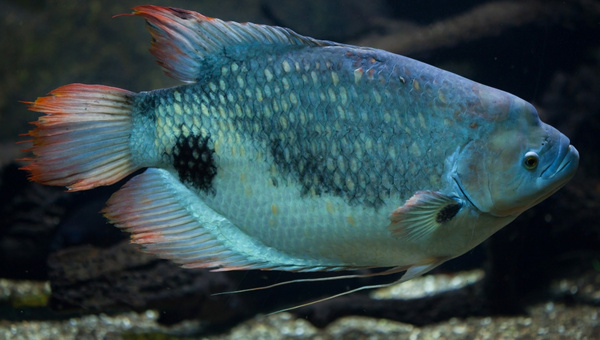
Firstly, Giant Gouramis need a lot of space. As such, fish keepers should provide them with a tank that can hold at least 200 gallons of water or more. Failing to offer Giant Gouramis sufficient space will result in depressed, unhealthy fish that will not live long.
Also, check: Bichir Ultimate Care Guide: Tankmates, Breeding, Diet, Types & All.
Secondly, Giant Gouramis are slow-moving fish and prefer to stay near the bottom of the tank. As such, live plants should be provided for them to hide in and around.
Thirdly, Giant Gouramis are tropical fish requiring warm water to thrive. An ideal temperature range for Giant Gouramis is between 68°-86°F, with a pH of 6.5-8.0.
Keeping the room temperature consistent with the tank temperature is crucial, as drastic temperature changes can harm or kill fish.
Filtration
When we talk about the filtration for Giant Gouramis, we discuss two types: mechanical and biological.
Mechanical filtration removes physical debris from the water, such as uneaten food, fish waste, and plant matter. This is typically done with a filter with a sponge or other media that captures the debris as water flows through it.
Also, check: Black Neon Tetra 101: Best Care Guide, Species Summary & All.
Biological filtration is the process of removing dissolved waste from the water using bacteria. These bacteria convert the trash into less harmful substances that the filter removes from the water.
We recommend using a canister filter with mechanical and biological filtration for a Giant Gourami tank. A canister filter will provide enough filtration for a Giant Gourami tank and ensure the water remains clean and clear.
Following are some commonly recommended filters for these fishes:
- Fluval FX6 Canister Filter
- Eheim Classic 2217 Canister Filter
- SunSun HW-304B 5-Stage External Canister Filter
You may also check: Zebra Pleco 101: Expert Care Guide, Lifespan, Diet & All
Heating
Giant Gouramis are tropical fish that require warm water to thrive. An ideal temperature range for Giant Gouramis is between 68°-86°F.
Keeping the room temperature consistent with the tank temperature is crucial, as drastic temperature changes can harm or kill fish. We recommend using an aquarium heater to maintain a constant water temperature.
Following are some commonly recommended heaters for these fishes:
- Aqueon Pro Series 150W Aquarium Heater
- Fluval E Series 100W Heater
Also, check: Blood Parrot Cichlid Best Care Guide, Lifespan, Size & All
Lighting
Giant Gouramis do not require special lighting and will do fine with standard aquarium lighting. However, if you wish to grow live plants in the tank, you will need to provide them with a light source.
For a Giant Gourami tank, we recommend using a fluorescent tube light. These lights are inexpensive, easy to find, and provide ample light for live plants.
Following are some commonly recommended lights for these fishes:
- Zoo Med AquaSun Aquarium Hood
- Fluval Plant Spectrum T5 HO Fluorescent Tube
Also, check: White Cloud Mountain Minnow 101: Species Summary & Detailed Care Guide
Plants
Giant Gouramis are slow-moving fish and prefer to stay near the bottom of the tank. As such, live plants should be provided for them to hide in and around.
Live plants also have the added benefit of providing the tank with much-needed oxygen and helping to remove harmful toxins from the water.
Some good plants for Giant Gourami tanks include:
- Anubias
- Java Fern
- Hornwort
- Sword Plants
Check: Snowball Pleco Ultimate Care Guide: Diet, Size, Tankmates & All
Substrate
The substrate is the material you put at the bottom of the tank. For a Giant Gourami tank, we recommend using gravel or sand. These substrates are easy to find, inexpensive, and easy to maintain.
Some suitable gravels for Giant Gourami tanks include:
- Fluval Eco-Gravel
- Marineland Black Diamond Blast Aquarium Gravel
- Some good sands for Giant Gourami tanks include:
- CaribSea Eco-Complete 20-Pound Planted Aquarium Substrate
- Fluval Vita-Sand 5-Pound Aquarium Substrate
Also, check: Common Pleco Ultimate Care Guide: Diet, Size, Tankmates & All
Decoration
Giant Gouramis are slow-moving fish and prefer to stay near the bottom of the tank. As such, live plants should be provided for them to hide in and around.
Other decorations, such as rocks and driftwood, can also be added to the tank. These decorations provide the fish with hiding places and make the tank more visually appealing.
Some good plants for Giant Gourami tanks include:
- Anubias
- Java Fern
- Hornwort
- Sword Plants
Cleaning the tank
You should perform a partial water change of 25% every other week. You will also need to vacuum the gravel and clean the filter media. Rinse the filter media in old tank water to prevent disrupting the beneficial bacteria colony.
To clean the tank, you will need the following:
- A sponge: A sponge can be used to wipe down the inside of the tank.
- A toothbrush: A toothbrush can be used to clean the filter.
- Freshwater: You will need fresh water to rinse off the sponge and toothbrush.
The steps for cleaning the tank are as follows:
- Remove the fish from the tank and put them in a temporary home.
- Remove all of the decorations from the tank.
- Use the sponge to wipe down the inside of the tank.
- Rinse the sponge and toothbrush with fresh water.
- Use the toothbrush to clean the filter.
- Rinse the sponge and toothbrush with fresh water.
- Add the decorations back to the tank.
- Add the fish back to the tank.
It is essential to clean the tank regularly to prevent the build-up of algae and bacteria. Algae and bacteria can be harmful to fish, and they can also cause the water to become cloudy.
Also, check Iridescent Shark 101: Size, Tankmates, Care Guide & All
Cleaning The Filter
It is essential to clean your filter regularly. A dirty filter can cause problems for your fish.
To clean your filter, you will need the following:
- A clean bucket: It is used to hold the old water.
- A garden hose: You can use it to rinse the filter media.
- Filter media: This is used to replace the old media.
To start, you will need to remove the filter from your tank. Then, use the clean bucket to hold the old water.
Next, use the garden hose to rinse the filter media. Finally, replace the old media with new media.
Check African Cichlid Care Guide: Diet, Tankmates, Lifespan & All
Giant Gourami Common Possible Diseases
Giant Gouramis are known to suffer from a few common diseases, including:
- Lymphocystis: This viral infection appears as white bumps or cysts on the fish’s body. It is not usually fatal but can be unsightly.
- Fin rot: This bacterial infection causes the fins to rot away. It is often fatal if left untreated.
- Columnaris: This is another bacterial infection that can cause severe damage to the skin and fins. It is also often fatal.
- Ich: This parasitic infection appears as white spots on the fish’s body. It is not usually fatal but can be very stressful for the fish.
- Velvet: This parasitic infection appears as a velvety coating on the fish’s body. It is often fatal if left untreated.
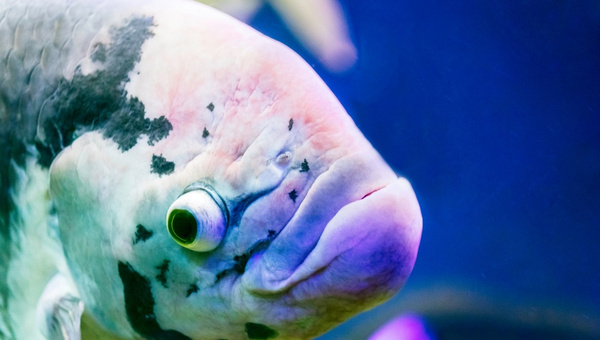
As you can see, Giant Gouramis are susceptible to a few common diseases. However, these diseases are often easily treatable if caught early.
Also, check Rainbow Shark Best Care Guide: Facts, Characteristics & All.
Prevention and Medications for these diseases
The best way to prevent these diseases is to quarantine new fish before adding them to your tank. This will allow you to treat any potential diseases before they have a chance to spread.
There are a few medications that can be used to treat these diseases:
- Lymphocystis: There is no specific treatment for this virus. However, the bumps can be removed surgically.
- Fin rot: This can be treated with various antibiotics, such as Kanamycin or Oxytetracycline.
- Columnaris: This can be treated with various antibiotics, such as kanamycin or oxytetracycline.
- Ich: This can be treated with various medications, such as malachite green or copper sulfate.
- Velvet: This can be treated with various medications, such as malachite green or copper sulfate.
As you can see, treatments are available for all of these diseases. However, the best way to prevent them is to quarantine new fish before adding them to your tank.
Check Twig Catfish (Farlowella acus) 101: Best Detailed Care Guide
Food and Diet
The Giant Gourami is a voracious eater who will consume just about anything that can fit into its mouth. Their diet consists primarily of smaller fish, crustaceans, and insects in the wild.
In captivity, they should be offered a variety of foods, including live, frozen, or freeze-dried foods such as bloodworms, brine shrimp, and daphnia, as well as pellets or flakes.
Following are some of the recommended food items for Giant Gouramis:
- Live foods such as bloodworms, brine shrimp, and daphnia
- Frozen or freeze-dried foods such as bloodworms, brine shrimp, and daphnia
- Pellets or flakes
Tank Mates
Gourami is not particularly compatible with other fish. They are often aggressive and territorial and fight with other fish they perceive as threatening. If you do decide to keep Gourami with other fish, it is essential to choose tank mates that are peaceful, non-aggressive, and of a similar size.
Good choices include other peaceful Gourami species, such as the dwarf Gourami, and other calm community fish like barbs, and rainbows.
Advantages Of Having Giant Gourami In Your Tank
Giant Gouramis are peaceful fish that makes a Great addition to any community tank. They are relatively easy to care for and are not as demanding as other fish species.
Another advantage of having Giant Gouramis in your tank is that they can help to keep the water clean and free of algae. These fish are known for their algae-eating habits and often graze on the tank’s algae growths.
This can help to keep the water quality high and prevent the growth of harmful algae blooms.
Also, check Bamboo Shrimp Care Guide, Appearance, Size, Diet, & All
Disadvantages Of Having Giant Gourami In Your Tank
While they may be beautiful fish, there are some disadvantages to keeping Giant Gouramis in your aquarium. One is that they can get quite large, up to three feet in length! This means they need a lot of space to swim around and could quickly outgrow a smaller tank.
Additionally, their diet consists mainly of live food, which can be expensive to keep up with and may require extra effort to ensure they’re getting enough nourishment.
Keeping Giant Gouramis can be a rewarding experience, but it’s essential to be aware of these potential downsides before committing.
Check Panther Grouper Care Guide: Appearance, Lifespan & Coloration & Breeding
Conclusion
Giant Gouramis fishes are suitable for aquariums, ponds, and water gardens. And it’s a beautiful, hardy fish that grow large. They make a great addition to any freshwater tank. Giant Gouramis are peaceful fish that get along well with other tank mates.
The Giant Gourami is a member of the Osphronemidae family, which contains many other popular freshwater aquarium fish, such as the kissing Gourami (Helostoma temminckii) and the dwarf Gourami (Trichogaster lalius).
The Giant Gourami is native to Southeast Asia. It can be found in Thailand, Laos, Cambodia, Vietnam, Malaysia, and Indonesia. They are labyrinth fish. This means it has a unique organ that allows it to breathe air. The Giant Gourami can live in water with shallow oxygen levels.
The Giant Gourami is a popular aquarium fish. It is easy to care for and can be a great addition to any freshwater tank. The Giant Gourami is a herbivore. It feeds on algae, plants, and small invertebrates in the wild. The aquarium should be fed a varied diet of vegetables, algae wafers, and sinking pellets or flakes.
The Giant Gourami is a peaceful fish that does well in community tanks. It should be kept with other mild fish of a similar size. The Giant Gourami is a hardy fish that is easy to care for. It is a good choice for beginner aquarium keepers! Thanks for reading.



